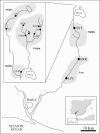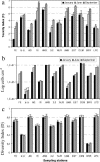Eukaryotic community distribution and its relationship to water physicochemical parameters in an extreme acidic environment, Rio Tinto (southwestern Spain)
- PMID: 16885283
- PMCID: PMC1538731
- DOI: 10.1128/AEM.00513-06
Eukaryotic community distribution and its relationship to water physicochemical parameters in an extreme acidic environment, Rio Tinto (southwestern Spain)
Abstract
The correlation between water physicochemical parameters and eukaryotic benthic composition was examined in Río Tinto. Principal component analysis showed a high inverse relationship between pH and most of the heavy metals analyzed as well as Dunaliella sp., while Chlamydomonas sp. abundance was positively related. Zn, Cu, and Ni clustered together and showed a strong inverse correlation with the diversity coefficient and most of the species analyzed. These eukaryotic communities seem to be more influenced by the presence of heavy metals than by the pH.
Figures




References
-
- Amaral, L. A., F. Gómez, E. Zettler, B. G. Keenan, R. Amils, and M. L. Sogin. 2002. Eukaryotic diversity in Spain's river of fire. Nature 417:137. - PubMed
-
- Baffico, G. D., M. M. Díaz, T. Wnzel, M. Koschorreck, M. Schimmele, T. R. Neau, and F. Pedrozo. 2004. Community structure and photosynthetic activity of epilithon from a highly acidic (pH<2) mountain stream in Patagonia, Argentina. Extremophiles 8:403-475. - PubMed
-
- Becks, L., F. M., Hilker, H. Malchow, K. Jürgens, and H. Arndt. 2005. Experimental demonstration of chaos in a microbial food web. Nature 435:1226-1229. - PubMed
-
- Boulter, C. A. 1996. Did both extensional tectonics and magmas act as major driver of convection cell during the formation of the Iberian Pyrite Belt massive sulfide deposits? J. Geol. Soc. Lond. 153:181-184.
Publication types
MeSH terms
Substances
LinkOut - more resources
Full Text Sources

